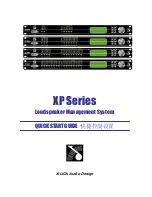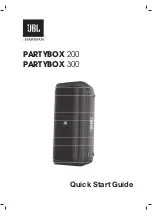
7
5.1: AC POWER REQUIREMENTS
PowerV™ products are equipped with Neutrik Powercon™ mains connectors which mate with the Neutrik NAC3FCA Cable
connector, quick lock with a securing lever for power-in. This AC mains connector is supplied with each PowerV™ product.
The amplifier operates between the ranges of 100 to 240 Volts; the auto ranging power supply detects the mains voltage
automatically and configures accordingly. Replace the mains fuse only with the same T10A HBC type. It is necesary to have
power local to eacvh speaker, as it is not possible to daisy chain the AC power connections.
5.2 COOLING
Do not install this equipment in an enclosed space. Do not limit free ventilation and movement of air around the back panel.
Ensure that there is at least 100mm (4") of space around all sides of the product for ventilation. An efficient switch mode power
supply has less weight, less current draw and more efficient mechanical cooling; meaning that no fans are required.
5.3 LED FUNCTIONS
Power LED –
When AC mains is connected to he speaker and the power switch is turned on the blue lower LED will illuminate.
Signal LED
– The Green LED indicates that a useable signal is present at the input.
Limit LED -
When illuminated this indicates that the system is approaching clipping.
An occasional flicker of the red LED on the loudest peaks is acceptable. If this LED remains red for more than the duration of
brief dynamic peaks, or lights continuously then the system is being overdriven.
If the red LED illuminates excessively:
• Reduce the input level (see interface panel)
• Reduce the output level of the mixer, or other source to the speaker.
5.5: AUDIO CONNECTIONS
Audio Connections
The signal input & link connectors are fully balanced.
SIGNAL
XLR CONNECTOR
When connecting a balanced signal be sure to wire
Hot (+)
Pin 2
to the following standard:-
Cold (-)
Pin 3
Shield (GND)
Pin 1
In a standard balanced interconnection there are two signal conductors and a shield. The shield is normally referenced to
ground at one or both ends. Many times the shield is lifted at one end, usually at the input to eliminate "ground loops" or noise.
The problem with this approach is that while it may reduce hum, the shields act as radio antennas and pickup radio frequency
interference from the environment.
Multiple enclosures may be driven from a single audio source; simply plug the signal source output into the first XLR input
socket, and patch that speakers XLR link to the next speakers XLR input socket & so on.
5.4 LIMITERS
The limiters are carefully set-up to preserve the loudspeakers dynamic headroom by allowing short term transients to pass;
audible degradation in sound will only become apparent when the limit indication is on constantly. The limiting functions will
protect the amplifier from long term overheating by attenuating the driving voltage to the drive units. If used irresponsibly
(constant hard clipping) sound quality will be compromised. In extreme cases drive units may also be damaged.
6.0: EQUALISATION
PowerV™ loudspeakers are designed to need no equalisation or correction to overcome system limitations. As a result, they
will only need equalisation to compensate for difficult acoustic environments.
Over equalisation can reduce system headroom, and introduce phase distortion resulting in greater problems than cures. If
equalisation is required then it should be applied gently and smoothly. PowerV™ full range loudspeakers are point source,
phase coherent designs and violent equalisation will be detrimental to the overall sound quality. When a loudspeaker is used
in close proximity to another, comb filtering effects can create coverage problems; comb filtering creates an uneven frequency
response across the coverage area due to constructive and destructive interference effects between the sources. The amount
of comb filtering is affected by the spacing of the relative sound sources. Minimising this effect cannot be cured by equalisation
(see the following section for more details).
Summary of Contents for V12HP
Page 1: ...POWER V6 POWER V8 POWER V12 POWER V12HP POWER V15 POWER VS10BP POWER VS15BP Owners Manual...
Page 17: ...17 10 4 SECUR ET V15Y V12Y V15Y V12Y...
Page 23: ...14 0 NOTES...
Page 24: ...NOTES...
Page 25: ...NOTES...
Page 26: ...NOTES...
Page 27: ...NOTES...








































